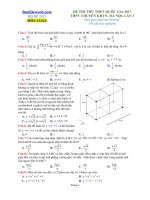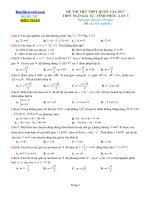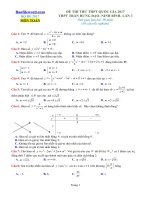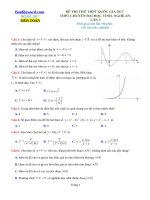50 cau hoi Kiem tra Unit 3 File word co loi giai chi tiet
Bạn đang xem bản rút gọn của tài liệu. Xem và tải ngay bản đầy đủ của tài liệu tại đây (133.9 KB, 11 trang )
Choose the word which is stressed differently from the rest.
Câu 1: A. attract
B. person
C. signal
D. instance
Câu 2: A. verbal
B. suppose
C. even
D. either
Câu 3:A. example
B. consider
C. several
D. attention
Câu 4: A. situation
B. appropriate C. informality D. entertainment
Câu 5: A. across
B. simply
C. common
D. brother
II. Choose A, B, C, or D that best completes each unfinished sentence.
Câu 6: She is a kind of woman who does not care much of work but generally _______
meals, movies or late nights at a club with her colleagues.
A. supposes
B. discusses
C. attends
D. socializes
Câu 7: I didn't think his comments were very appropriate at the time.
A. correct
B. right
C. suitable
D. exact
Câu 8: You should _______ more attention to what your teacher explains.
A. make
B. get
C. set
D. pay
Câu 9: Body language is a potent form of _______ communication.
A. verbal
B. non-verbal
C. tongue
D. oral
Câu 10: Our teacher often said, "Who knows the answer? _______ your hand."
A. Rise
B. Lift
C. Raise
D. Heighten
Câu 11: This is the instance where big, obvious non-verbal signals are appropriate.
A. matter
B. attention
C. place
D. situation.
Câu 12: They started, as _______ gatherings but they have become increasingly formalized
in the last few years.
A. informal
B. informally
C. informalize
D. informality
Câu 13: Children who are isolated and lonely seem to have poor language and ________.
A. communicate
B. communication
C. communicative
D. communicator
Câu 14: The lecturer explained the problem very clearly and is always _______ in response
to questions.
A. attention
B. attentively
C. attentive
D. attentiveness
Câu 15: Pay more attention _______ picture and you can find out who is the robber.
A. to
B. for
C. at
D. on
Câu 16: She looked _______ me, smiling happily and confidently.
A. on
B. forward to
C. over
Câu 17: What an attractive hair style you have got, Mary! - _______
A. Thank you very much. I am afraid
B. You are telling a lie
D. at
C. Thank you for your compliment
D. I don't like your sayings
Câu 18: In _______ most social situations, _______ informality is appreciated.
A. Ø / Ø
B. the / an
C. a / the
D. the / a
Câu 19: What_______ beautiful dress you are wearing! - Thank you. That is _______ nice
compliment.
A. Ø / Ø
B. the / Ø
C. a / a
D. the / the
Câu 20: ______ you wanted to ask your teacher a question during his lecture, what would
you do?
A. As
B. As if
C. Even of
D. suppose
Câu 21: John asked me _______ in English.
A. what does this word mean
B. what that word means
C. what did this word mean
D. what that word meant
Câu 22: The mother told her son _______ so impolitely.
A. not behave
B. not to behave
C. not behaving
D. did not behave
Câu 23: She said she _______ collect it for me after work.
A. would
B. did
C. must
D. had
C. were
D. have been
Câu 24: She said I _______ an angel.
A. am
B. was
Câu 25: I have ever told you he _______ unreliable.
A. is
B. were
C. had been
D. would be
Câu 26: I told him _______ the word to Jane somehow that I _______ to reach her during the
early hours.
A. passing / will try
B. he will pass / tried
C. to pass / would be trying
D. he passed / have tried
Câu 27: Laura said she had worked on the assignment since _______.
A. yesterday
B. two days ago
C. the day before
D. the next day
Câu 28: John asked me _______ interested in any kind of sports.
A. if I were
B. if were I
C. if was I
D. if I was
Câu 29: I _______ you everything I am doing, and you have to do the same.
A. will tell
B. would tell
C. told
D. was telling
Câu 30: John asked me _______ that film the night before.
A. that I saw
III. Error Identification.
B. had I seen
C. if I had seen
D. if had I seen
Câu 31: According to Mehrabian in1971, only 7% of the information we communicate to
others depends upon the words we saying; 93% of that depends on non-verbal
communication
A. According to
B. only 7%
C. to others
D. we saying
Câu 32: Body language is quiet and secret, but most powerful language of all.
A. Body language
B. and secret
C. most
D. of all
Câu 33: Our bodies send out messages constantly and sometimes we do not recognize that
we are using many nonverbal language.
A. send out
B. messages
C. we do not recognize D. many
Câu 34: Our understanding and use of non-verbal cues in facial expressions and gestures
are familiar to us nearly in birth
A. Our understanding B. in facial expressions C. are familiar
D. in
Câu 35: A person's body postures, movements but positions more often tell us exactly what
they mean
A. A person's
B. but
C. exactly
D. what
IV. Read the passage carefully and choose the correct answer.
BODY LANGUAGE AND CULTURAL DIFFERENCES
The body language people use often communicates more about their feelings than the
words they are saying. We use body movements, hand gestures, facial expressions, and
changes in our voice to communicate with each other. Although some body language is
universal, many gestures are culturally specific and may mean different things in different
countries.
If you want to give someone the nod in Bulgaria, you have to nod your head to say no
and shake it to say yes – the exact opposite of what we do! In Belgium, pointing with your
index finger or snapping your fingers at someone is very rude.
In France, you shouldn't rest your feet on tables or chairs. Speaking to someone with
your hands in your pockets will only make matters worse. In the Middle East, you should
never show the soles of your feet or shoes to others as it will be seen as a grave insult. When
eating, only use your right hand because they use their left hands when going to the
bathroom.
In Bangladesh, the 'thumbs-up' is a rude sign. In Myanmar, people greet each other by
clapping, and in India, whistling in public is considered rude.
In Japan, you should not blow your nose in public, but you can burp at the end of a
meal to show that you have enjoyed it. The 'OK' sign (thumb and index finger forming a
circle) means 'everything is good' in the West, but in China it means nothing or zero. In
Japan, it means money, and in the Middle East, it is a rude gesture.
Câu 36: It is mentioned in the passage that many gestures __________.
A. may mean different things in different countries
B. are not used to communicate our feelings
C. can be used to greet each other in public
D. are used in greeting among men and women
Câu 37: People nod their head to say no in __________.
A. Belgium
B. Bulgaria
C. France
D. Japan
Câu 38: In the Middle East, people do not use their left hands for eating because they use
their left hands________.
A. when going to the bathroom
B. when preparing the meal
C. to put in their pockets
D. to clean their tables and chairs
Câu 39: Which of the following is NOT true according to the passage?
A. In France, people shouldn’t rest their feet on tables.
B. In Belgium, snapping your fingers at someone is very rude.
C. In China, the ‘OK’ sign means money
D. In Myanmar, people greet each other by clapping
Câu 40: The word “others” in paragraph 3 refers to __________.
A. other people
B. other shoes
C. other soles
D. other feet
V. Fill in each numbered blank with one suitable word or phrase.
Researchers in communication show that more feelings and intentions are _______ and
received nonverbally than verbally. Mehrabian and Wienerfollowing have stated that only 7%
_______ message is sent through words, with remaining 93% sent nonverbal _______.
Humans use nonverbal communication because: Words have limitations: There are _______
areas where nonverbal communication is more _______ than verbal, especially when we
explain the shape, directions, personalities which are expressed nonverbally. Nonverbal
signal are powerful: Nonverbal cues primarily express inner _______ while verbal messages
deal basically with outside world. [primarily: mainly] Nonverbal message are likely _______
more genuine: because nonverbal behaviors cannot be controlled as easily as spoken words.
Nonverbal signals can express feelings inappropriate to state: Social etiquette/’etiket/ [nghi
thức] limits _______ can be said, but nonverbal cues can communicate thoughts. A separate
communication channel is necessary to _______ send complex messages: A speaker can add
enormously to the complexity of the verbal message through simple nonverbal _______.
Câu 41: A. sent
B. posted
C. mailed
D. thrown
Câu 42: A. through
B. in
C. of
D. for
Câu 43: A. thought
B. expressions C. gestures
D. postures
Câu 44: A. sum
B. great deal C. amount
D. numerous
Câu 45: A. effect
B. effective
C. effectively D. effectiveness
Câu 46: A. feelings
B. words
C. shows
D. sorrows
Câu 47: A. be
B. being
C. to be
D. been
Câu 48: A. what
B. that
C. why
D. when
Câu 49: A. get
B. have
C. make
D. help
Câu 50: A. signs
B. signals
C. sight
D. signatures
LỜI GIẢI CHI TIẾT
Câu 1: Đáp án A
attract /ə'trỉkt/(v) hút, thu hút, hấp dẫn, lơi cuốn
person /'pə:sn/(n) con người, người
signal /'signl/(n) dấu hiệu, tín hiệu; hiệu lệnh
instance /'instəns/(n) thí dụ, ví dụ (chứng minh, minh hoạ)
Vậy đáp án A, trọng âm nhấn vào âm tiết thứ 2, đáp án còn lại vào âm tiết thứ 1
Câu 2: Đáp án B
verbal /'və:bəl/(adj) (thuộc) từ, (thuộc) lời
suppose /sə'pouz/ (v) giả sử, giả thiết, giả định
even /ˈiːvn/ ngay cả, thậm chí
either /'aiðə,(Mỹ)'i:ðə/(adj) , (conj)mỗi (trong hai), một (trong hai), hoặc
Vậy đáp án B, trọng âm nhấn vào âm tiết thứ 2, đáp án còn lại vào âm tiết thứ 1
Câu 3: Đáp án C
example /ig'zɑ:mpl/(n) thí dụ, ví dụ
consider /kən'sidə/(v) cân nhắc, xem xét, suy xét, suy nghĩ
several /'sevrəl/(adj) vài
attention /ə'tenʃn/(n) sự chú ý
Vậy đáp án C, trọng âm nhấn vào âm tiết thứ 1, đáp án còn lại vào âm tiết thứ 2
Câu 4: Đáp án B
situation /,sitju'eiʃn/(n) vị trí, địa thế
ppropriate /ə'proupriit/(adj) (+ to, for) thích hợp, thích đáng
informality /,infɔ:'mỉliti/(n) tính chất khơng theo thủ tục quy định, tính chất khơng chính
thức, hành vi khơng chính thức
entertainment /,entə'teinmənt/(n) sự tiếp đãi; sự chiêu đãi; buổi chiêu đãi
Vậy đáp án B, trọng âm nhấn vào âm tiết thứ 2, đáp án còn lại vào âm tiết thứ 3
Câu 5: Đáp án A
across /ə'krɔs/(adv) qua, ngang, ngang qua
simply /'simpli/(adv) chỉ là; thường là
common /'kɔmən/(adj) chung, công, công cộng
brother /'brʌðə/(n)anh; em trai
Vậy đáp án A, trọng âm nhấn vào âm tiết thứ 2, đáp án còn lại vào âm tiết thứ 1
Câu 6: Đáp án B
Giải thích:Discuss st with sb: thảo luận cái gì với ai
Attend(v) dự, có mặt
Suppose(v) giả định, địi hỏi, tin rằng
Socialize(v) xã hội hóa
Câu 7:
Câu 15: Đáp án A
To pay attention to st: chú ý đến
Dịch nghĩa: Chú ý kĩ hơn đến bức tranh và bạn sẽ có thể tìm ra ai là kẻ cướp
Câu 16: Đáp án D
Look at sb: nhìn ai
Look forward to(doing)st: háo hức làm gì
Look down on sb: coi thường ai
Look over: kiểm tra
Dịch nghĩa: Cơ ấy đã nhìn tơi, cười một cách hạnh phúc và tự tin
Câu 17: Đáp án C
C. Thank you for your compliment- Cảm ơn vì lời khen của bạn
Thank you very much. I am afraid- Cảm ơn nhiều, tôi đang thấy sợ
You are telling a lie- Bạn đang nói dối
I don't like your sayings- Tơi khơng thích những lời nói của bạn
Dịch nghĩa: Bạn có mái tóc thật thu hút, Mary- Cảm ơn lời khen của bạn
Câu 18: Đáp án A
Giải thích:Khơng dùng mạo với các danh từ mang nghĩa chung chung, hay một số danh từ
không đếm được
Informality(n) sự thân mật
Câu 19: Đáp án C
Giải thích:
Cấu trúc câu cảm thán: What + a/an + N …!
Compliment(danh từ đếm được ) : lời khen –
Danh từ đếm được số ít đi sau mạo từ ‘a’
Dịch nghĩa:Chiếc váy bạn đang mặc thật đẹp! – Cảm ơn bạn, thật là một lời khen tốt đẹp
Câu 20: Đáp án D
Suppose(v) giả sử, giả định
As if: như thể là
Even: ngay cả, thậm chí
Câu này tương tự như câu điều kiện loại 2, đưa ra giả thiết khơng có thật ở hiện tại
Dịch nghĩa: Giả sử bạn muốn hỏi giáo viên một câu hỏi khi cơ/anh ấy đang giảng bài, bạn sẽ
làm gì?
Câu 21: Đáp án D
Giải thích: Mệnh đề danh ngữ với Wh- question : thứ tự các từ loại như trong câu khẳng định:
Wh-question + S + V (lùi thì)
Dịch nghĩa: John đã hỏi tơi từ đó có nghĩa là gì trong tiếng anh
Câu 22: Đáp án B
Tell sb (not) to do st: bảo/u cầu/ nói với ai (khơng) làm gì
Dịch nghĩa: Người mẹ yêu cầu con trai không được cư xử vơ lễ như vậy
Câu 23: Đáp án A
Giải thích: Đây là câu gián tiếp, tương lai đơn dạng will+V được chuyển thành ‘would
+V’(lùi thì)
Dịch nghĩa: Cơ ấy đã nói là cơ ấy sẽ thu thập nó cho tơi sau giờ làm
Câu 24: Đáp án B
Giải thích: Đây là câu gián tiếp, trong câu trực tiếp ‘I am…’ chuyển thành ‘I was…’ (lùi thì)
Dịch nghĩa: Cơ ấy đã nói rằng tơi là một thiên thần
Câu 25: Đáp án A
Giải thích: Với tính từ chỉ đặc điểm, tính cách, tính chất cố định của người, sự vật thì ‘to be’
thường chia ở thì hiện tại đơn
Dịch nghĩa: Tơi đã từng nói với bạn là anh ta khơng đáng tin cậy
Câu 26: Đáp án C
Giải thích: Tell sb (not) to do st: bảo/yêu cầu/ nói với ai (khơng) làm gì
Đây là câu gián tiếp, tương lai tiếp diễn trong câu gốc trực tiếp là ‘will be trying’ – lùi thì sẽ
thành ‘would be trying’
Pass the word to sb: chuyển lời đến ai
Dịch nghĩa: Tơi nói với anh ấy bằng cách nào đó hãy chuyển lời tới Jane rằng tôi sẽ gặp cô ấy
sớm
Câu 27: Đáp án C
Giải thích:Trong câu gián tiếp ‘yesterday’- chuyển thành ‘the day before’
Dịch nghĩa:Laura nói rằng cơ ấy đã làm cơng việc được giao từ ngày hôm trước
Câu 28:
Câu 34: Đáp án D
Đáp án D-> from
Giải thích: from(prep) từ, có từ (chỉ nơi phát ra, nơi bắt nguồn, nơi xuất phát)
Dịch nghĩa: Sự hiểu biết và sử dụng các ám chỉ không lời từ biểu hiện nét mặt và các cử chỉ
đã quen thuộc với chúng ta gần như là từ khi sinh ra
Câu 35: Đáp án B
Đáp án B-> and
Giải thích: Để liệt kê các từ loại có cùng chức năng về ngữ pháp và ngữ nghĩa, ta dùng liên từ
‘and’, với các từ đối lập nghĩa, dùng liên từ ‘but’
Dịch nghĩa: Dáng điệu cơ thể, sự chuyển động và tư thế của một người thường cho ta biết
chính xác ý của họ là gì.
Câu 36: Đáp án A
Giải thích: many gestures are culturally specific and may mean different things in different
countries.
Dịch nghĩa: nhiều cử chỉ là đặc trưng của nền văn hóa và có thể mang nghĩa khác nhau ở
những đất nước khác nhau
Câu 37: Đáp án B
Giải thích: If you want to give someone the nod in Bulgaria, you have to nod your head to say
no
Dịch nghĩa: Nếu bạn muốn gật đầu với ai đó ở Bulgaria, bạn phải gật đầu để nói khơng
Câu 38: Đáp án A
Giải thích: When eating, only use your right hand because they use their left hands when
going to the bathroom.
Dịch nghĩa: Khi ăn, chỉ sử dụng tay phải của bạn bởi vì họ sử dụng tay trái khi đi vào phòng
tắm.
Câu 39: Đáp án C
Giải thích: The ‘OK’ sign (thumb and index finger forming a circle) means ‘everything is
good’ in the West, but in China it means nothing or zero.
Dịch nghĩa: Các dấu hiệu 'OK' (ngón cái và ngón trỏ tạo thành một vịng trịn) có nghĩa là "tất
cả mọi thứ đều tốt ' ở phương Tây, nhưng ở Trung Quốc nó có nghĩa là khơng có gì hoặc số
khơng
Câu 40: Đáp án A
Giải thích: . ‘In the Middle East, you should never show the soles of your feet or shoes to
others as it will be seen as a grave insult’ Others = other people
Dịch nghĩa: . Tại Trung Đông, bạn không bao giờ nên để lòng bàn chân hoặc giày của bạn
cho người khác thấy vì nó sẽ bị xem như là một sự xúc phạm nghiêm trọng.
Câu 41: Đáp án A
Giải thích: send out: gửi đi
Câu 42: Đáp án C
Giải thích: of (prep) của, thuộc, từ , trong số , trong đám
Câu 43: Đáp án B
Giải thích: expression(N) sự biểu lộ, biểu hiện
Gesture(n) cử chỉ
Posture: tư thế
Câu 44: Đáp án D
Numerous(adj) đông đảo, nhiều
A great deal/amount of + N: nhiều
Câu 45: Đáp án B
Giải thích: effective(adj) hiệu quả
More + adj + than… : cấu trúc so sánh hơn, chỗ trống cần điền tính từ
Câu 46: Đáp án A
Giải thích: Feeling(n) cảm xúc
Sorrow(n) nỗi buồn
Câu 47: Đáp án C
Giải thích: be likely + to V : có khả năng
Câu 48: Đáp án A
Giải thích: what = the thing that (đại từ quan hệ)
‘What can be said’ là cụm danh từ: những gì có thể được nói
Câu 49: Đáp án D
Help(v) giúp đỡ, trợ giúp
Câu 50: Đáp án B
Giải thích:Signal(n) tín hiệu
Sight(n) sự nhìn, tầm nhìn, cảnh tượng
Signature(n) chữ kí
Sign(n) dấu hiệu, kí hiệu









